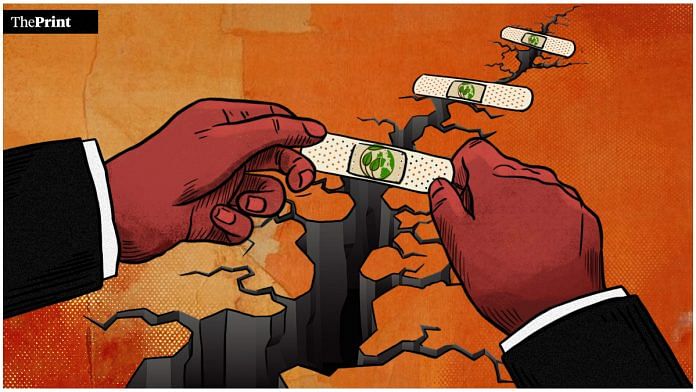It has been a year since Joshimath was in the news. By 12 January 2023, the town had sunk by almost 14 cm, there were cracks in the ground, and residents had to be moved from their homes. Reports suggest that as of January 2024, many residents have returned to their unsafe homes because help for relocation has not been provided. Climate change is often perceived as a phenomenon without a proximate cause—such as changing weather patterns, unseasonal floods, and heatwaves—resulting from human activity over extended periods. Joshimath may not fit the exact description, given that large construction projects could be the immediate cause. However, the devastation seen here is a harbinger of what might happen to other regions in India and its neighbours as impacts of climate change begin to surface.
Our policy focus so far has largely been on mitigation efforts such as the shift to renewables. But we also need to expand our climate policy toolkit to include robust adaptation strategies. Climate adaptation is the process of adjustment to actual or expected climate and its effects. This could mean building structures that are better able to cope with heat waves or floods, changing agricultural patterns, or relocating from areas prone to climate disasters. For climate adaptation to work, multiple policy actions will have to be taken simultaneously.
Decentralised decision making
First, decision-making for adaptation has to be at the local government level. Decentralisation is important in general, but vulnerability to climate events varies dramatically across different locations, requiring governments to respond to local challenges. Whether its afforestation, reforestation, flood and heatwave fortifications, implementing land-use regulations and building standards, or providing welfare transfers to the most vulnerable, local decision-making is essential.
The challenge for India is to ensure that sub-national governments have the capacity to design projects, raise and deploy finance from multiple sources, and exercise their regulatory muscle appropriately. This requires identifying changes in current administrative processes that can empower local governments to make quicker decisions without diluting accountability. Additionally, there’s a need for changes in legal and regulatory structures to facilitate easier access to pools of capital. More importantly, it requires further upskiling the human resources within local governments to deliver adaptation solutions.
Diversifying sources of finance
Second, most funding for adaptation is currently available as loans or grants from multilateral development banks or other climate funds. This is not going to be enough. India has to think about innovative financial instruments, such as blended finance, where capital is pooled from different sources with various financial and non-financial return expectations. If we want to leverage private, especially foreign, capital for adaptation, then we must encourage structures such as guarantees, co-financing, and first-loss equity facilities (where a public or multilateral fund agrees to bear initial losses in an investment to stimulate participation by others). Since different instruments are governed by regulations that may be at odds with each other, regulatory impediments to blended finance should be assessed to allow for diverse structures.
Role of credit and insurance markets
Third, households and businesses have every incentive to fortify their homes or their livelihoods in anticipation of climate change. If heat waves decrease productivity, then factories have an incentive to change the timing of their shifts, or install air conditioning—at least when the cost is outweighed by the benefits to productivity. Credit markets will factor in climate change risks when making lending decisions. For example, loans for residential or commercial projects in areas with a high probability of flooding should be more expensive than those in less risky locations. Similarly, infrastructure projects in areas at greater risk of climate events should face higher financing costs. Home insurance premiums should also reflect the probability of a climate event in specific areas. Financial markets need to start integrating climate risks more centrally in their credit and insurance decisions.
Also Read: Why surge pricing can spark a brighter future for solar power
Leveraging data for solutions
Fourth, responses to adaptation can only be built on the basis of data on the probability of an event and the potential losses that may result from it. A good example of the use of data and models for adaptation comes from the Netherlands, where the 1985 flood led to the design of “optimal dyke heights” to save the city from inundation. The height was decided based on the marginal investment cost of building the dyke and the marginal expected damage that would be avoided. Recently, the Dutch water programme restored the natural flood plains based on revised probabilities of fatalities and the economic damage that rising sea levels due to climate change might cause. The lesson here is the use of climate risk data to conduct a cost-benefit analysis for specific solutions.
The state plays an important role by collecting and disseminating data on the risks faced by every neighbourhood. As climate models get better, we will have more accurate and granular information about risks and the potential costs and benefits of adaptation actions. This data will be important for households and firms alike to craft their individual climate adaptation strategies.
Renuka Sane is research director at TrustBridge, which works on improving the rule of law for better economic outcomes for India. She tweets @resanering. Views are personal.
(Edited by Asavari Singh)



